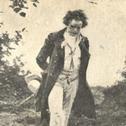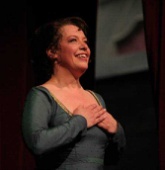 Michael Tilson Thomas, the remarkable Music Director & Conductor of the San Francisco Symphony, celebrates his 20th anniversary with the orchestra with a three week long Beethoven Festival, June 10-28, 2015. The gifted MTT has made a gift to the City–and anyone lucky enough to be visiting–of the great music and of one of his own many gifts: a genius for programming. Last night, June 17, the Hedgehogs and and an eager full-house audience heard Overture to the Ballet, The Creatures of Prometheus, Op. 43; Concerto No. 4 in G major for Piano and Orchestra, Op. 52; Ah! Perfido, Scene and Aria, Op. 65; and Symphony No. 6, Op. 68, Pastoral. It was a blissful evening that moved from thrills to calm transcendence.
Michael Tilson Thomas, the remarkable Music Director & Conductor of the San Francisco Symphony, celebrates his 20th anniversary with the orchestra with a three week long Beethoven Festival, June 10-28, 2015. The gifted MTT has made a gift to the City–and anyone lucky enough to be visiting–of the great music and of one of his own many gifts: a genius for programming. Last night, June 17, the Hedgehogs and and an eager full-house audience heard Overture to the Ballet, The Creatures of Prometheus, Op. 43; Concerto No. 4 in G major for Piano and Orchestra, Op. 52; Ah! Perfido, Scene and Aria, Op. 65; and Symphony No. 6, Op. 68, Pastoral. It was a blissful evening that moved from thrills to calm transcendence.  Beethoven’s Overture was brief and full of wonders. It especially intrigued this listener for its continual rhythmic invention. There is a swirling action of the music related to the introduction of human enlightenment in the sciences and the arts through the interventions of the gods. The story is not necessary, indeed, this Hedgehog had not read program notes which allowed the music to dance on its own. Once begun, the energy and magic of the music spins and lifts the listener to a momentary meeting on Parnassus. It ended quickly; the gods and their intertwining rhythms receded to the clouds.
Beethoven’s Overture was brief and full of wonders. It especially intrigued this listener for its continual rhythmic invention. There is a swirling action of the music related to the introduction of human enlightenment in the sciences and the arts through the interventions of the gods. The story is not necessary, indeed, this Hedgehog had not read program notes which allowed the music to dance on its own. Once begun, the energy and magic of the music spins and lifts the listener to a momentary meeting on Parnassus. It ended quickly; the gods and their intertwining rhythms receded to the clouds.
 Jonathan Biss is tall, slight, and has the long, graceful hands one imagines for an acclaimed pianist. He also has a magnetic presence onstage which was a perfect match for the SF Symphony in Concerto No. 4. It seemed to me to be unusual for the pianist to begin a Concerto, and it is. The piano offers its thoughts. The orchestra responds. The fascinating rhythms noticed in The Creatures of Prometheus were a good mental preparation for the variety of rhythmic creativity in this Concerto. At one moment, as the Symphony was busily having its say, one note from the piano appeared clearly as though breaking in while its partner had only one beat to catch its breath. Mr. Biss’s fan-like hands compress for the astonishing trills that punctuate the piano’s poetry as the piano leads the orchestra into another atmosphere. The Concerto is spritely and touching. It seems to cleanse the air all around it. The SF Symphony performed as though this Concerto were its own; Mr. Biss gave an inspiring performance, far beyond exact or correct, lifting us up into Beethoven’s world.
Jonathan Biss is tall, slight, and has the long, graceful hands one imagines for an acclaimed pianist. He also has a magnetic presence onstage which was a perfect match for the SF Symphony in Concerto No. 4. It seemed to me to be unusual for the pianist to begin a Concerto, and it is. The piano offers its thoughts. The orchestra responds. The fascinating rhythms noticed in The Creatures of Prometheus were a good mental preparation for the variety of rhythmic creativity in this Concerto. At one moment, as the Symphony was busily having its say, one note from the piano appeared clearly as though breaking in while its partner had only one beat to catch its breath. Mr. Biss’s fan-like hands compress for the astonishing trills that punctuate the piano’s poetry as the piano leads the orchestra into another atmosphere. The Concerto is spritely and touching. It seems to cleanse the air all around it. The SF Symphony performed as though this Concerto were its own; Mr. Biss gave an inspiring performance, far beyond exact or correct, lifting us up into Beethoven’s world.
 Soprano Karita Mattila’s performance of Ah! perfido was her debut with the SFS. She is a much honored opera performer who added drama and character to the Festival evening. She is a statuesque blonde who used the clarity of her diction and technique to create powerful, expressive theater. The aria addresses a lover, the “perfidious, perjured, barbarous traitor,” who has left the singer. How is it possible that there could be an idiot who would leave Ms. Mattila’s character? She endowed her performance with all the anger, hurt, despair, and pain that could seize a goddess or even ten goddesses. “In pity’s name, do not say farewell,/for what, deprived of you, shall I do?” The aria was an interesting addition to the programming. It demonstrated the breadth of Beethoven’s reach into all forms of music. It arrested the attention of the audience with the power of the voice.
Soprano Karita Mattila’s performance of Ah! perfido was her debut with the SFS. She is a much honored opera performer who added drama and character to the Festival evening. She is a statuesque blonde who used the clarity of her diction and technique to create powerful, expressive theater. The aria addresses a lover, the “perfidious, perjured, barbarous traitor,” who has left the singer. How is it possible that there could be an idiot who would leave Ms. Mattila’s character? She endowed her performance with all the anger, hurt, despair, and pain that could seize a goddess or even ten goddesses. “In pity’s name, do not say farewell,/for what, deprived of you, shall I do?” The aria was an interesting addition to the programming. It demonstrated the breadth of Beethoven’s reach into all forms of music. It arrested the attention of the audience with the power of the voice.
 And then, Beethoven’s 6th Symphony. It brings us into harmony with the natural world. It offers tranquility. Like a walk through a lovely park, it never disappoints anyone willing to listen. There are commentaries from learned Beethoven specialists who either state simply that this symphony has a “program,” meaning it describes a particular scene and events, or who try to step around that a little, as music with a program may not be truly great music to them. This is truly great music. Beethoven loved to walk in park or wood. “No one can love the country as much as I do,” he wrote, “For surely woods, trees, and rocks produce the echo which man desires to hear.” Yes, even rocks. There is a Shakespearian gathering of rough musicians which could be right out of A Midsummer Night’s Dream. They may be clumsy, but the author/composer loves them just as he values the rocks and trees. There is a terrible storm, but it passes over, and we are all safe together again. He captures the rhythms of putting one foot in front of another, of jumping over a brook, not a very big brook, of breathing air fresher than one’s usual air. It is steady and calm and beautiful. The SF Symphony’s superb performance captured the world changing beauty of the calm, easy breathing work. Would it be possible to convert those who deny the tragedy of climate change by having them listen to Beethoven’s 6th? It is a hard, closed heart which could not hear the call in this music full of supposedly common wonders.
And then, Beethoven’s 6th Symphony. It brings us into harmony with the natural world. It offers tranquility. Like a walk through a lovely park, it never disappoints anyone willing to listen. There are commentaries from learned Beethoven specialists who either state simply that this symphony has a “program,” meaning it describes a particular scene and events, or who try to step around that a little, as music with a program may not be truly great music to them. This is truly great music. Beethoven loved to walk in park or wood. “No one can love the country as much as I do,” he wrote, “For surely woods, trees, and rocks produce the echo which man desires to hear.” Yes, even rocks. There is a Shakespearian gathering of rough musicians which could be right out of A Midsummer Night’s Dream. They may be clumsy, but the author/composer loves them just as he values the rocks and trees. There is a terrible storm, but it passes over, and we are all safe together again. He captures the rhythms of putting one foot in front of another, of jumping over a brook, not a very big brook, of breathing air fresher than one’s usual air. It is steady and calm and beautiful. The SF Symphony’s superb performance captured the world changing beauty of the calm, easy breathing work. Would it be possible to convert those who deny the tragedy of climate change by having them listen to Beethoven’s 6th? It is a hard, closed heart which could not hear the call in this music full of supposedly common wonders.
Tonight, June 18, The Hedgehogs hear the SF Symphony, Jonathan Biss, and the Symphony Chorus perform Sanctus, from the Mass in C maj., Choral Fantasy, op. 80; Fantasy in G Maj., op. 86; and Symphony No.5. I will look for Winston Churchill. I feel sure he will be there.
For tickets to the Beethoven Festival concerts: sfsymphony.org or call 415/864-6000.
 Both the San Francisco Giants and the Oakland A’s are playing home games. The Giants’ game is at 4:05 p.m. The Pride Parade will have moved past the stadium by then.
Both the San Francisco Giants and the Oakland A’s are playing home games. The Giants’ game is at 4:05 p.m. The Pride Parade will have moved past the stadium by then. In Golden Gate Park: The Turner exhibition is up at the de Young Museum, Alice Radio’s Summerthing brings live music and food trucks from 12-4, the Dunsmuir dance company offers Scottish music and dance from 1 -2:45 (free), and all the usual attractions from the Japanese Tea Garden to the Bison are there for you.
In Golden Gate Park: The Turner exhibition is up at the de Young Museum, Alice Radio’s Summerthing brings live music and food trucks from 12-4, the Dunsmuir dance company offers Scottish music and dance from 1 -2:45 (free), and all the usual attractions from the Japanese Tea Garden to the Bison are there for you.








